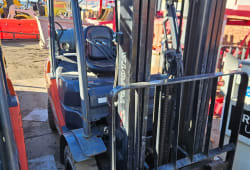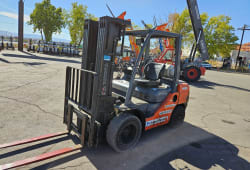Navigating How Forklift Technology Improves Safety and Efficiency
8 Min read
)
April 4, 2023
Forklifts are essential for many industries, and while they provide a convenient way to move heavy loads, they can also pose safety risks to operators, pedestrians and bystanders. Fortunately, advancements in forklift technology have significantly improved safety and efficiency in recent years. In this guide, we will explore the various technologies and tools that have been developed to enhance forklift safety and efficiency and the benefits they provide to businesses.
:format(webp))
Safety Features
Advancements in forklift technology have greatly improved safety. Technologies and components such as proximity sensors, load-sensing technologies, automatic speed control, automated braking systems, and operator detection have been developed to reduce the risk of accidents and injuries in forklift operations.
Proximity Features and Cameras
Proximity sensors and cameras are key technological advancements in forklift technology that greatly enhance safety. Proximity sensors alert the operator when they are getting too close to an object or person, helping drivers prevent collisions and accidents. Cameras provide the lift truck an additional layer of visibility, allowing operators to see their surroundings more clearly, identify potential hazards, and avoid potential collisions.
Load-Sensing Technology
Load-sensing technology is a key innovation that has significantly increased forklift safety. This technology allows the forklift operator to detect the weight of the load being lifted and adjust its performance accordingly, preventing accidents caused by overloading. Load-sensing technology also reduces the risk of tipping over, as it ensures that the forklift's center of gravity remains within safe limits while lifting heavy loads. This safety feature provides forklift operators with greater control and precision, reducing the likelihood of accidents and improving the safety of forklift operations in various industries.
Automatic Speed Control and Braking
Automated speed control and braking systems are crucial advancements in forklift technology that significantly improve safety in the workplace. These systems are designed to detect potential collisions and adjust the speed of the forklift accordingly, helping to prevent accidents. Automated braking systems, or automated technologies such as anti-lock braking systems (ABS), provide additional safety features by allowing the forklift to come to a quick and controlled stop in emergency situations. These systems also reduce operator fatigue and improve forklift drivers' efficiency by reducing the need for constant manual braking and speed adjustments.
Quick Guide: Forklift Performance
Operator Detection Features
Operator detection and safety features are key technological advancements in forklifts that greatly enhance safety in the workplace. These occupational safety features use sensors and cameras to detect operator behaviour and prevent unsafe actions, such as operating the forklift without a seatbelt or with an elevated load of heavy equipment. The technology can also prevent unauthorized access to the forklift and ensure that only trained and authorized personnel operate the equipment, reducing the risk of accidents and injuries. Overall, these safety features provide additional layers of protection for both operators and other individuals in the vicinity of the forklift.
Safety Technology in Action
In 2020, a large global retailer implemented a safety system on their forklifts that used cameras and sensors to detect any potential hazards in the surrounding environment. The system automatically slowed down the forklift's path or brought it to a stop if it detected an object or person in the way. Thanks to this modern technology, workers at the company reported a significant reduction in forklift-related accidents, which previously accounted for a large percentage of their workplace injuries. The system also increased productivity by reducing the time required for operators to manually adjust the speed of the forklift.
In another example, a manufacturer of electrical equipment installed a load-sensing system on their forklifts, which allowed for training of the operators to accurately weigh loads and avoid overloading. The system provided real-time feedback to the operator and adjusted the performance of the forklift to ensure that the load remained within safe limits. As a result, the company reported a significant reduction in accidents caused by overloading, as well as improved efficiency due to the training and the reduction in manual load weighing and adjustments. The load-sensing system also helped to extend the lifespan of the forklifts and reduced maintenance costs.
:format(webp))
Improved Efficiency
In addition to improving workplace safety, forklift technology advancements have also enhanced efficiency in various industries. Technologies such as electric power and automation have greatly reduced fuel costs, increased the productivity of employees, and improved overall efficiency in the workplace.
Electric Forklifts
Electric forklifts are becoming increasingly popular vehicles due to their energy efficiency and low emissions. These forklifts are powered by rechargeable batteries, which are much cheaper than traditional gas or diesel engines. Advances in battery technology have greatly extended the range and lifespan of electric forklifts, making them a more viable option for businesses looking for other vehicles to reduce their carbon footprint while increasing efficiency.
Automated Storage and Retrieval Systems
Automated storage and retrieval systems (ASRS) are another technological advancement in automated forklifts that has greatly improved efficiency in warehouses and distribution centres. ASRS uses automated machines to move and store products, eliminating the need for manual labour. These systems have a higher storage capacity and can move products faster and more accurately than traditional forklifts. They also allow for easy tracking and monitoring of inventory, reducing the risk of human error and improving supply chain management. ASRS technology has revolutionized the storage and retrieval process, enabling businesses to increase efficiency, save time, and reduce labour costs.
:format(webp))
Inventory Management Systems
Inventory management systems are another example of how forklift technology has enhanced efficiency in the workplace. These systems use sensors and software to monitor inventory levels, track product movement and automatically order replenishments when necessary. By streamlining the inventory process, businesses can reduce costs associated with manual labour and improve accuracy in inventory tracking. Additionally, the real-time data provided by these systems enables businesses to make informed decisions about product placement, ordering, and shipping, further increasing efficiency in the supply chain.
Automated and Autonomous Forklifts
One of the most significant advances in forklift technology is the development and operation of automated and autonomous forklifts. These forklifts use sophisticated sensors, scanners, and software to efficiently navigate their way through a warehouse or industrial facility. They are programmed with specific tasks and can be programmed to follow a set route or to follow a specific worker. They can even be programmed to recognize and avoid obstacles, improving safety and efficiency.
Autonomous forklifts can also detect and respond to changes in their environment. This means they can respond quickly to any changes in the warehouse or industrial facility, such as a sudden change in the load they are carrying. This helps to reduce the risk of accidents in the workplace and can help companies to improve productivity.
Remote Monitoring and Predictive Maintenance
Remote monitoring and predictive maintenance can greatly reduce downtime in the workplace. With remote monitoring, forklifts can be monitored and diagnosed for potential issues before they become major problems. Predictive maintenance uses data and analytics to predict when maintenance is required, allowing scheduled maintenance to occur before any issues arise. By reducing downtime, businesses can increase productivity and save money by using less downtime and avoiding costly repairs and lost time.
:format(webp))
Efficiency Technology in Action
In 2021, a large logistics company implemented an automated storage and retrieval system in their warehouse facilities, replacing traditional forklifts with mobile robots. The system included an inventory management system that tracked inventory levels and automatically replenished stock when necessary. As a result, the company was able to reduce labor costs by 30%, while increasing their storage capacity by 50%. The automated system also reduced the time required to fulfill orders, improving their delivery times and customer satisfaction.
Another example is a manufacturing company that switched to electric forklifts powered by lithium-ion batteries. The company previously used gas-powered forklifts, which required frequent refueling and maintenance. By switching to electric forklifts, the company was able to reduce their fuel costs by 60% and save an additional 20% on their vehicle maintenance and repair costs. The electric forklifts also had a longer lifespan, requiring less frequent replacements. Overall, the switch to electric forklifts allowed the company to save money and increase efficiency while reducing their carbon footprint.
:format(webp))
Conclusion
Advanced forklift technology is revolutionizing the way warehouses and industrial operations operate, maximizing safety and efficiency. Automated and autonomous forklifts can help to reduce the risk of accidents and improve efficiency. In addition, increased safety features and improved efficiency features can help to reduce the strain on the forklift driver and increase the overall efficiency of operations. By investing in advanced forklift technology, warehouses and industrial operations can benefit from increased safety and efficiency.
Visit Boom & Bucket to buy and sell your machinery.

Aaron Kline is the Co-Founder and COO of Boom & Bucket, where he leverages his extensive leadership experience to revolutionize the heavy equipment industry. With a background in building scalable processes and teams from his time as a Naval officer and executive roles in tech, Aaron focuses on introducing cutting-edge technology to construction and agriculture markets. Before Boom & Bucket, he held leadership positions at Skylo and Yard Club (acquired by Caterpillar), and he’s passionate about fostering innovation and driving efficiency in under-digitized industries.

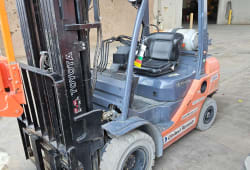
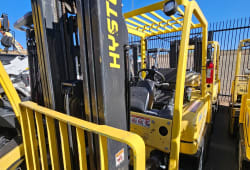
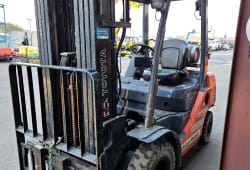
:format(webp))

